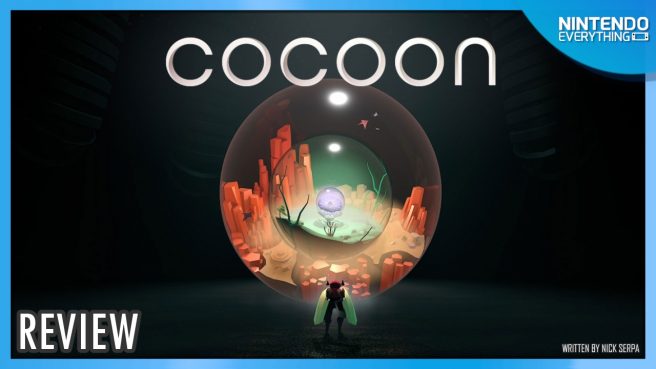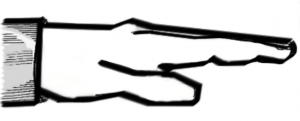[Review] Cocoon
Posted on October 7, 2023 by Nicholas Serpa in News, Reviews, Switch eShop
System: Switch
Release date: September 8, 2023
Developer: Geometric Interactive
Publisher: Annapurna Interactive
Cocoon’s mechanical brilliance is the subtle kind, the kind that sneaks up on you. I knew going into my playthrough that this was the next project from Jeppe Carlsen, the lead gameplay designer of highly acclaimed side-scrollers Limbo and Inside; that type of pedigree sets high expectations, which for me were amplified further after a summer media demo left me with more questions than answers. The most important distinction to note with Cocoon is that it’s more outwardly a puzzle game than either of its forebears, and a very clever one; its trippy, entangled web of worlds is one big metapuzzle that’s true depth astonishes the deeper one dives into it. It’s also a game that somehow builds atmosphere masterfully, but frustratingly refuses to contextualize its world or provide any real stakes, narrative or even lore to engage with. Having rolled credits, I’m still unsure what exactly was the point of my little mechanical bug’s world-bending journey; this, combined with some technical issues on Switch, results in a game that somehow manages to both impress and disappoint at once.
Unlike many other puzzle-driven games in which individual logic challenges are scattered across a game world, what makes Cocoon so unique is that the world itself is the puzzle. As a lightfooted biomechanical insect, you begin by exploring a rocky, sunset-hued desert and initially dealing with simple challenges, like how to align moving platforms to cross a canyon. It’s not long, though, before players will discover a strange teleporter-like platform; activating it will see our anthropod flutter its wings and launch itself out of that world entirely, and into a new one. Each world in Cocoon is contained within a glass orb that our traveling bug can carry on its back, while also acting as its own power source to activate other machines like bridges and doors.

Cocoon actually has players working with up to four orbs at once, each one containing a world to traverse and jump in and out of. The tricky part is that your bug can only carry one orb at a time. What this means is that very quickly, Cocoon becomes a game about carrying worlds into other worlds, strategically using their energy to activate machines and explore, and then ultimately using more teleporters to move deeper inward or outward through these layered worlds. Some of the trickier puzzles in the game will have you needing to, for example, place the green world in the orange world, the orange world in the purple world, then finally the purple world in the white world, and then jump back out to the white world to carry all four worlds with you to some switch you need to activate. Then, you might jump back down a few worlds and rearrange the spheres within each other some other way to help solve a puzzle at the outer-most world.
The other element that makes traversal a puzzle in of itself is that each of Cocoon’s colored world-spheres has a special ability attached to it that’s required to navigate certain obstacles. For example, carrying the green world-sphere lets the player interact with elevators, whereas the white world-sphere can fire a projectile that can be used to activate certain switches. One puzzle later in the game needed me to activate a switch with the white world-sphere, but the switch was located in an area that required me to use the green world-sphere to access it. Being able to only carry one object at a time, I first had to find a teleporter so that I could carry the white sphere into the green one, letting me traverse the first set of obstacles with both worlds carried on my back; then, later, I could pull the white sphere back out to solve the second layer of the puzzle.

It’s the type of thing that sounds convoluted on paper and is admittedly a bit difficult to explain, but to Cocoon’s credit, the game is masterfully paced and does an excellent job slowly introducing these mechanics. By the time you reach the game’s most complex puzzles, you’ll likely be confidently jumping in and out of worlds, carrying them between each other and feeling really smart while you do it. Cocoon strikes the perfect balance between being challenging without feeling frustrating; I always felt like I was given all the tools and the cumulative knowledge of how the tools interact with each other. With each puzzle seemingly having only one intended solution, I was surprised at how often I felt clever for figuring out how to navigate a tricky set of obstacles; the “a-ha” moments feel earned. It evoked a lot of the same feelings I felt the first time I played Portal, which is about the highest praise I can offer for a puzzle game.
Then there are the boss battles, which are quite literally completely different beasts. These giant, imposing bio-mechanical monstrosities lie partway through each world, but because Cocoon is a combat-free experience, they each represent a sort of puzzle to solve. The difference is that for these foes, there’s no element of world-shifting required to beat them; instead defeating each of these foes relies more on learning their attack patterns so you can use the environment to exploit their weaknesses. An early boss had me picking up a tunneling explosive insect to toss at them while dodging hornets and shards of crystal, with its final defeat granting me a new ability for the world-sphere it previously controlled. I won’t spoil the impressive late-game bosses, but they’re impressive to face off against, incredibly well-animated, and fun to take down; that said, they likely won’t have you thinking as hard as the rest of the game does.

Exploring Cocoon’s worlds between these encounters, I found myself impressed by the strong artistic direction of each biome, even if each region feels a bit sparse in meaningful detail. Don’t get me wrong – the sense of atmosphere is rich and layered, selling the idea that this world you’re navigating is both organic and synthetic, with creatures and structures simultaneously pulsing like living animals and whirring like machines. And the stellar sound design impresses, with every action you perform being accentuated by the clicks or buzzing of a device being activated, or by the pitter of rain on the swamp puddles below your feet. Visually, it’s all extremely sharp and colorful – striking, but never exhausting or overly demanding of your attention. Occasionally, it can feel mysterious. But the beauty is skin-deep, and the worlds themselves are often quite sparse and repetitive; yes, you’ll see interesting details here and there, but you’ll often see them so frequently that you feel like you’re retreading a lot of the same ground. The brevity of Cocoon – four to five hours – makes this less of an issue, but I ultimately felt like the game’s worlds existed solely as backdrops for puzzles, rather than as distinct places that I wanted to see more of.
Some of this, I feel, could have been alleviated if the game had sought out richer worldbuilding, but there’s essentially no narrative at all in Cocoon, and here in particular I really missed its absence. Not all puzzle games need to have a straightforward story to compel, of course, but Cocoon’s complete disinterest at contextualizing any of the surreal and potentially interesting elements of its world just left me with a general apathy to what I was seeing – outside of the incredible puzzles, of course. I can appreciate games that hide their answers behind subtle lore that requires deeper player investigation, but Cocoon doesn’t really seem interested in laying substantial enough groundwork to make that possible.

Compare this to Limbo and Inside; those games are also opaque, sure, but they embrace environmental storytelling at such a high caliber that players can at least somewhat piece together what they think is happening, or can at least hit up forums to debate the mysteries that are presented. Cocoon, though, doesn’t provide enough in-world context for players to be able to do even that; its world is truly little more than a backdrop for its puzzles. That’s fine, but it could have been so much more. Cocoon’s ending cutscene feels almost like what should have been an introduction; it left me wanting to play more, but mostly because I was unsatisfied with how it all failed to come together narratively in a meaningful way.
My final grievance is that Cocoon really struggles to maintain a consistent framerate on Switch outside of the opening area. I don’t know what exactly is going on beyond the scenes, but it seems like in most biomes, even just walking can cause Cocoon’s frame-rate to plunge in the low twenties, and occasionally even lower when the screen is awash with particle effects or heavy lighting. It’s very distracting, and not even a hard reset of my Switch improved the situation. Handheld mode fared a bit better, but in docked mode – where admittedly the game is gorgeously crisp – it all cumulates in a very choppy experience. For a puzzle-focused game, I was able to tolerate it, but it really put a damper on my playthrough.
The Verdict
Cocoon is an excellent puzzle game, and if that’s enough for you, you’ll likely be blown away by just how clever its Inception-like puzzles can get; the core conceit of carrying entire worlds through other worlds and then back out of each other is unique, intuitively designed, and simply feels great to execute. The game punctuates these clever stretches of world-hopping with punchy boss encounters that are snappy and tense, if a bit distant from most of Cocoon’s core mechanics. Unfortunately, in addition to some very distracting technical issues, Cocoon’s worlds can often feel repetitive and lacking in meaning, and the game wastes its surreal and mysterious atmosphere by failing to engage in any real world-building or even basic storytelling to engage the player at a deeper level. These issues may not be dealbreakers for some, but for me, they cumulated in a game that made me feel clever more often than not, but failed to draw me into the world as it so clearly felt intended to do.
Cocoon review copy provided by the publisher for the purposes of this review.

